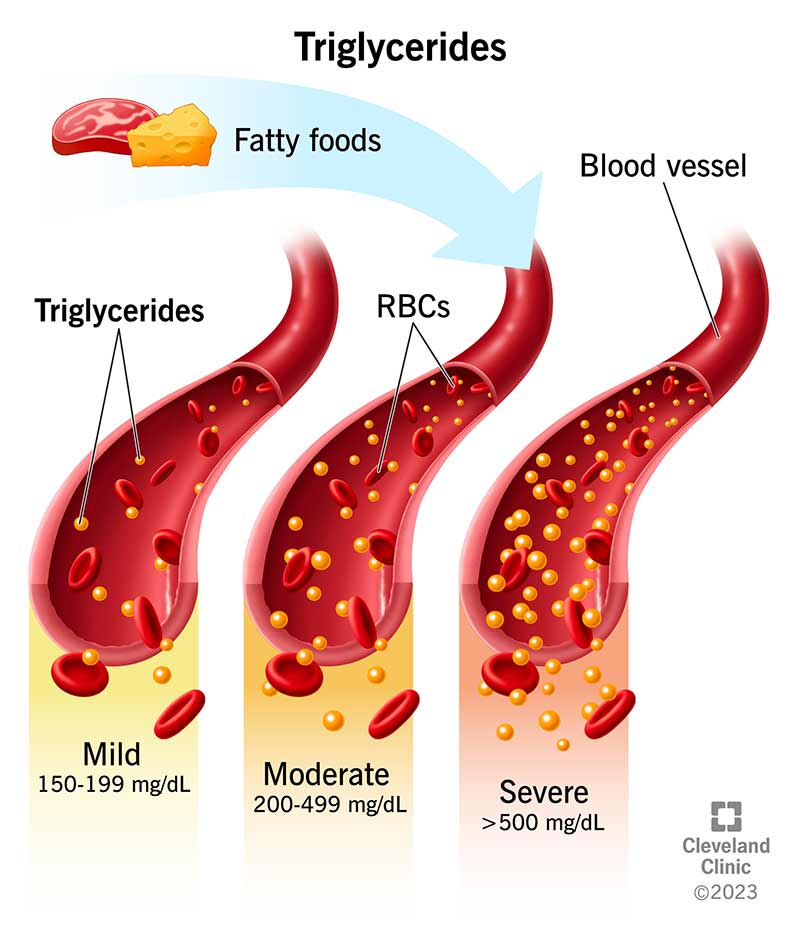Triglycerides are a very common kind of fat in your body. They’re in butter and other fats in food. You also make triglycerides from extra calories to use later. But high triglyceride levels can raise your risk of issues like heart attacks and strokes. Exercise and other healthy habits can bring triglyceride levels back to normal.
Advertisement
Cleveland Clinic is a non-profit academic medical center. Advertising on our site helps support our mission. We do not endorse non-Cleveland Clinic products or services. Policy

Triglycerides are fats from the food we eat. Most of the fats we eat (like butter) are in triglyceride form. Extra calories, alcohol and sugar in your body turn into triglycerides. Your body stores them in fat cells throughout your body like stocking shelves in a pantry. You can use triglycerides later when you need them.
Advertisement
Cleveland Clinic is a non-profit academic medical center. Advertising on our site helps support our mission. We do not endorse non-Cleveland Clinic products or services. Policy
High triglycerides (hypertriglyceridemia) can put you at a higher risk of heart and vascular (blood vessel) disease. This includes heart attack and stroke. About 25% of people in the U.S. have high triglycerides.
Triglycerides and cholesterol are both fatty substances called lipids. But triglycerides are fats; cholesterol isn’t. Cholesterol is a waxy substance your liver makes. Your body uses it to build cell walls and help your nervous system. It also plays an important role in digestion and hormone production.
Pure cholesterol can’t mix with or dissolve in blood. Instead, your liver packages cholesterol with triglycerides and proteins called lipoproteins. The lipoproteins move this fatty mixture to areas throughout your body.
Types of these lipoproteins include:
For adults, your healthcare provider classifies high triglyceride levels as:
For adults, a normal triglyceride level is below 150 mg/dL. For young people between ages 10 and 19, a normal number for triglycerides is below 90 mg/dL.
Advertisement
Your healthcare provider figures out your total cholesterol by looking at a combination of triglycerides, HDL and LDL numbers. If your triglycerides and LDL cholesterol are high, but your HDL is low, you have an increased risk of heart attack and stroke.
Like high cholesterol, high triglycerides rarely cause symptoms. That’s why you need to get routine lipid blood tests to check cholesterol numbers. For the most accurate reading, you should fast eight to 12 hours before a lipid blood test.
High levels of triglycerides increase your risk of pancreatitis. This severe and painful inflammation of the pancreas can be life-threatening.
High triglyceride levels also increase your risk of heart and vascular disease, including:
Causes of high triglycerides include:
Factors that may raise your risk of high triglyceride levels include:
High triglyceride levels become more of a problem with age. As the risk rises, your healthcare provider might recommend tests more often.
Adults in their 20s, 30s and early 40s may need cholesterol tests every four to six years. If you have diabetes, a family history of high cholesterol or other heart disease risk factors, you may need more frequent tests.
Males over 45 need a test every year. Females over 55 also need annual tests.
If you have cardiovascular disease or you’re taking medications to lower your cholesterol or triglyceride levels, your healthcare provider or cardiologist might check your triglyceride levels more frequently.
Yes, children need cholesterol and triglyceride tests. Providers usually test children between ages 9 and 11 and again during young adulthood (between ages 17 and 21). If a child has a family history of high cholesterol, heart attacks or strokes, their provider may do tests as early as age 2.
Changes to your diet and lifestyle can lower triglyceride numbers. To keep triglycerides and total cholesterol within a healthy range:
Advertisement
People at high risk for heart attacks, strokes or other problems may need medications to lower triglycerides. These may include cholesterol-lowering drugs such as statins.
High levels of triglycerides increase your risk of heart disease and pancreatitis. Eating or drinking too many calories can lead to high triglyceride levels. The good news is that you can take steps to lower triglyceride numbers. Your healthcare provider can offer suggestions for heart-healthy lifestyle changes. If needed, medications can also help.
Advertisement
Cleveland Clinic’s primary care providers offer lifelong medical care. From sinus infections and high blood pressure to preventive screening, we’re here for you.

Last reviewed on 08/09/2023.
Learn more about the Health Library and our editorial process.